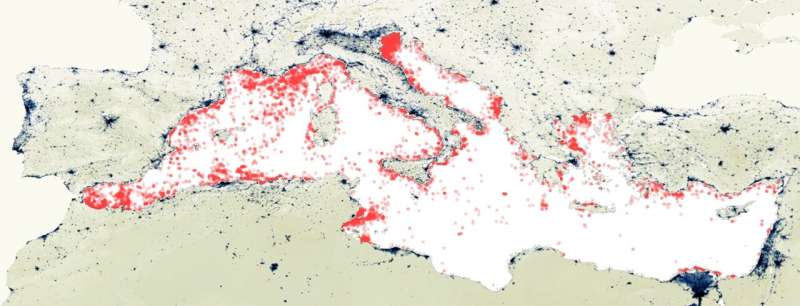Detecting marine debris from space has become a reality, according to a new study by the Institute of Marine Sciences (ICM-CSIC) and the University of Cádiz, recently published in the journal Nature Communications.
Until now, the amount of mostly plastic debris on the sea surface was rarely large enough to generate a signal that could be detected from space. But using supercomputers and advanced search algorithms, the research team showed that satellites are an effective tool for estimating the amount of debris in the sea.
To carry out the study, a six-year series of historical observations from the European satellite Copernicus Sentinel-2 in the Mediterranean was analyzed. A total of 300,000 images taken at a resolution of 10 meters were examined every 3 days. The results revealed large accumulations of debris inside floating structures known as “floating structures”, which can be up to several kilometers long and are the result of the convergence of ocean currents and the impact of wind on the sea surface.
Although the satellite’s sensors were not specifically designed to detect litter, their ability to detect plastic helped map the most polluted parts of the Mediterranean. This map shows the main points where debris enters from the mainland and improves our understanding of the mechanisms that transport debris.
The results show that the amount of plastic floating in the Mediterranean could cover an area of approximately 95 square kilometers between 2015 and 2021, the equivalent of approximately 7,500 football fields.
“Until now, searching for clusters a few meters in diameter on the ocean surface has been like looking for a needle in a haystack, as the formation of clusters requires the presence of large amounts of debris and the presence of weak winds to prevent it.” Manuel Arias (ICM-CSIC), one of the study’s co-leaders, explains:
Andres Kosar from the University of Cádiz, one of the co-chairs of the research, emphasizes that “the importance and relevance of roads for marine debris has not been known until now” and welcomes the fact that “automation with supercomputers” is possible. and advanced search algorithms made it possible to prove that it is possible to monitor marine debris accumulation over large areas and on a regular basis from space.”
In terms of future space missions, the research group proposes installing special plastic detection sensors on satellites. This would increase the chances of detecting plastic in the ocean by 20 times, according to the study. Additionally, this information can be compared with other environmental factors to better understand the mechanisms by which plastic waste is transferred from land to sea and provide better guidance for actions and regulations to combat such marine pollution, which affects biodiversity, fish stocks and marine pollution. tourism.
Population density is an important factor
The study concluded that factors such as population density, geography and rainfall patterns have a significant impact on the accumulation of marine debris. For example, desert countries or cities contribute much less to the problem, while areas that receive more rainfall have much greater accumulations of debris from emissions in the previous days and weeks, especially when there are heavy rains.
Finally, the study shows that most continental debris is confined to the first 15 kilometers of the sea from the shore and returns to the shore after a few days or months. “This supports the idea that the distribution of plastic debris produced by human activities of continental origin and directly in the sea behaves and disperses differently,” explains Arias.
The authors of the study demonstrate the applicability of the new methodology with several real-life cases, such as assessing the effectiveness of action plans to combat litter in the Tiber River in Rome (Italy), identifying marine pollution hotspots. Use of satellite observations to manage transportation in the Suez Canal (Egypt) or work on cleaning the waters of the Bay of Biscay (Spain).
However, the results of the study show that satellite monitoring of marine pollution is also applicable and promising for solving problems other than plastic. For example, a sensor specifically designed to detect and identify floating objects could help solve problems such as cargo loss on ships, oil spills, or search and rescue operations at sea.
In addition to Cadiz University and ICM-CSIC, the team also includes researchers from the European Space Agency (ESA), ARGANS France, Polytechnic University of Catalonia (Spain), National Research Consortium (ISMAR-CNR, Italy), and Technical University. Crete (Greece), ARGANS Ltd. (Great Britain), ARGANS Ltd. (USA), ARGANS Ltd. (Great Britain), ARGANS Ltd. (France), ARGANS Ltd. (Spain), ARGANS Ltd. (Italy), ARGANS Ltd. (USA), ARGANS Ltd. (Great Britain), ARGANS Ltd. (France). (UK), AIRBUS Defense and Space (France), European Commission Joint Research Center (JRC), The Ocean Cleanup (Netherlands) and ACRI-ST (France).
Source: Port Altele
